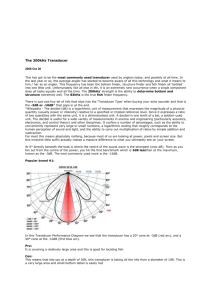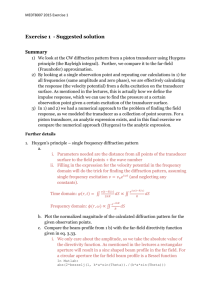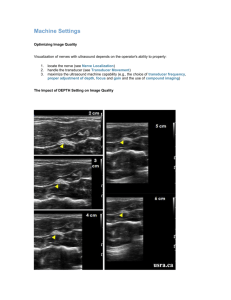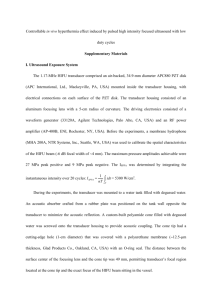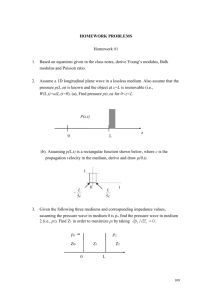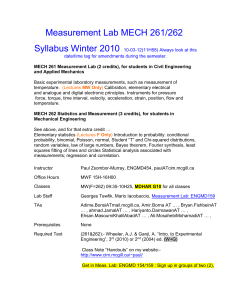LABORATORY REPORT COVER PAGE
advertisement
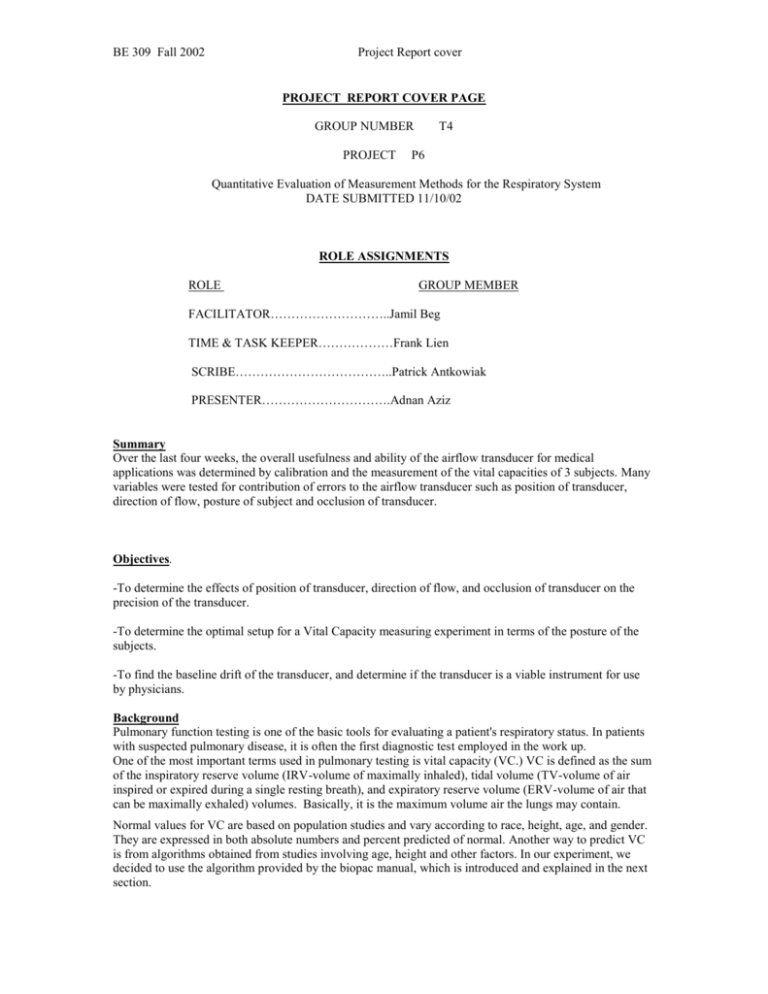
BE 309 Fall 2002 Project Report cover PROJECT REPORT COVER PAGE GROUP NUMBER PROJECT T4 P6 Quantitative Evaluation of Measurement Methods for the Respiratory System DATE SUBMITTED 11/10/02 ROLE ASSIGNMENTS ROLE GROUP MEMBER FACILITATOR………………………..Jamil Beg TIME & TASK KEEPER………………Frank Lien SCRIBE………………………………..Patrick Antkowiak PRESENTER………………………….Adnan Aziz Summary Over the last four weeks, the overall usefulness and ability of the airflow transducer for medical applications was determined by calibration and the measurement of the vital capacities of 3 subjects. Many variables were tested for contribution of errors to the airflow transducer such as position of transducer, direction of flow, posture of subject and occlusion of transducer. Objectives. -To determine the effects of position of transducer, direction of flow, and occlusion of transducer on the precision of the transducer. -To determine the optimal setup for a Vital Capacity measuring experiment in terms of the posture of the subjects. -To find the baseline drift of the transducer, and determine if the transducer is a viable instrument for use by physicians. Background Pulmonary function testing is one of the basic tools for evaluating a patient's respiratory status. In patients with suspected pulmonary disease, it is often the first diagnostic test employed in the work up. One of the most important terms used in pulmonary testing is vital capacity (VC.) VC is defined as the sum of the inspiratory reserve volume (IRV-volume of maximally inhaled), tidal volume (TV-volume of air inspired or expired during a single resting breath), and expiratory reserve volume (ERV-volume of air that can be maximally exhaled) volumes. Basically, it is the maximum volume air the lungs may contain. Normal values for VC are based on population studies and vary according to race, height, age, and gender. They are expressed in both absolute numbers and percent predicted of normal. Another way to predict VC is from algorithms obtained from studies involving age, height and other factors. In our experiment, we decided to use the algorithm provided by the biopac manual, which is introduced and explained in the next section. BE 309 Fall 2002 Project Report cover The biopac lesson states that the confidence interval of the equation is +/- 20%. It is important to note that the equation used to was created by taking thousands of subjects and finding a best-fit line. According to respiratory-care.com, less than 80% of predicted Vital Capacity is considered to be abnormal. Considering that the confidence interval for the formula is 20%, this makes some sense. Theory and Methods of Calculation - The Vital Capacity can be found from an equation given in Biopac Student Lab Lesson 13: Pulmonary Function II. VC = 0.052H – 0.022A – 3.60 H = height in centimeters A = age in years VC = vital capacity in liters - The Vital Capacity can also be found experimentally through the Biopac Pro software. The peak-topeak value from the highest peak at maximum inhalation and lowest peak from maximum exhalation are taken. The result is in liters. - Percent error values are found from a standard error equation, for our purposes, it is this: % error = ((equation value – experimental value)/equation value) * 100 Materials, Apparatus, and Methods The procedure for determining the vital capacity was taken from biopac lesson 12. For each trial, lasting approximately 1 minute, three normal (tidal) breaths are taken, then the deepest inhalation possible (IRV), three normal breaths, and then deepest exhalation possible (ERV). From this airflow data, the integral was taken, to determine the volumes. Results Figure 1: Variations on the Airflow Transducer without Induced Flow A measure of accuracy was performed upon the airflow transducer at no induced flow to see if various preexperimental factors would introduce error into data collected. A standard, upright (90 degree) reading from the airflow transducer, without any induced flow, produced a 0.08 +/- 0.12L volume. Data collected with one end covered with parafilm to obstruct any backflow produced a 0 +/- 0.01L volume. The .08L reading is therefore attributed to the air current in the room passing through the transducer. It can not be expected of a subject to hold the transducer at the specified 90 degrees at all time, therefore we tested the BE 309 Fall 2002 Project Report cover accuracy of the device at different angles, assuming that a subject would not deviate from the 90 degrees by more than 10 degrees in either direction. Angling the device 10 degrees towards the subject produced a 0 +/- 0.01L mean volume while angling the device 10 degrees away produced a 0.01 +/- 0.02L mean volume. Therefore angling the device 10 degrees in either direction can alter the resulting data by approximately 0.08L. It may also be expected that the subject may not hold the transducer totally still during the experiment. Moving the transducer up and down during recording of data exhibited a 0.006 +/- 0.008L mean volume. Figure 2: Reversal of Transducer During Calibration Calibration of the transducer was done with a respirator set at a volume of 0.6L. The mean volume obtained after three trials with the respirator was 0.57 +/- 0L. The volume obtained from the transducer was 0.03L less than the expected 0.6L the respirator was set up for. Early on we found that reversing the transducer (i.e. Utilizing the transducer with the cord attaching the transducer to the computer to the right of the subject instead of the left) produced not only slightly different data, but also reversed the data in the sense that the usual peaks in the waveforms became troughs, and the troughs became peaks. The mean volume obtained after three trials with the respirator with transducer reversal produced a mean volume of 0.54 +/- 0.03L. This is only 0.03L different than the volume for the transducer in the normal position. Figure 3: Vital Capacities of Smokers and Non-smoker One of the purposes of the transducer is to measure the vital capacity of a subject. The equation given for the expected vital capacity of a male subject (as given above) was consistently much higher than the values obtained during the experiment. For two subjects who smoked, the deviation from the equational vital capacity was expected, but the deviation was not expected for the non-smoker. These tests were done with the subjects sitting down except for some trials with the first subject (a smoker) standing. For the two smokers and the non smoker the equational vital capacity was 4.92L, 5.21L, and 6.00L respectively, while the experimental, sitting, mean vital capacity was 2.66 +/- 0.67L, 3.13 +/- 0.36L, and 3.94 +/- 0.13L respectively. This produced a percent error of 46%, 40%, and 34% respectively. The first subject was asked to stand to see if sitting restricted the lung’s vital capacity. The mean vital capacity from standing for this subject was 3.58 +/- 0.14L with a percent error of 27%. The initial testing of the transducer’s ability to measure vital capacity did not attest to the transducer’s accuracy from calibration. Therefore, the problem was in the subjects. This time, the two smokers were asked to do breathing exercises and to stretch out their lungs to obtain their full vital capacity before performing the experiment. The stretching helped increase the vital capacity of these subjects. The vital capacities obtained from stretching first are 4.91L and 4.23L for subjects 1 and 2 respectively. The percent error in comparison with the equational value is 0.2% and 19% for subjects 1 and 2 respectively. This is a significant improvement over the high percent error values taken from data with the subjects sitting. It is therefore shown that the airflow transducer can be an effective tool in measuring a subject’s vital capacity. Discussion During last four weeks, the accuracy and precision of an airflow transducer were tested. Airflow transducers record the flow rate of air from inhalations and exhalations. From this data, the volume may be calculated. The vital capacity, the maximum volume of air in the lungs at deepest inhalation, was calculated by taking the peak to peak from deepest inhalation and deepest exhalation (with three tidal (normal) breaths before, after and in between). Reproducing the data with three subjects is unrealistic due to obvious constraints on number of subjects and time. As a result, the idea to test females along wit e 3 male subjects was rejected because no correlation would be able to be made. In addition, it is also very important to note that the above equation does not take weight into consideration. Weight is definitely a factor that should not be left out. A 300 lbs man who is six feet six inches all will not have the same vital capacity as a 300 lbs man who is five feet two inches tall. This is because the fat in the abdomen pushes up on the diaphragm prohibiting full expansion. Initial values from the first week were unusually low. The predicted values of subjects 1, 2, and 3, were 4.94L, 5.21L, 6.00L, respectively. These were 45.9%, 40%, and 34.3% off from the expected vital capacity. Originally, the accuracy of the device was questioned. However, it was determined that the BE 309 Fall 2002 Project Report cover posture, all subjects were sitting in a chair, constrained the ribs of the subject prohibiting full expansion, greatly contributing to the source of error since vital capacity is a measure of the maximum volume. The next week, subjects stood and the air transducer was fixed with a ring-stand at an optimal height for each subject. The experimental value was 3.58L for subject 1. The percent error from the accepted equation for subjects 1 was 27.2%, thus decreasing the error by 18.7%. Standing allows for greater rib a greater range of expansion; thereby increasing the expiratory reserve volume (the volume of air that can be maximally exhaled.) During the final week, each subject stretched his back, abdomen, and shoulders for approximately fifteen minutes. Stretching these muscles allow for greater rib expansion and a higher vital capacity. The experimental values were 4.91L and 4.23L for subjects 1 and 2 respectively. The percent error from the accepted equation for subjects 1 and 2 were .2% and 19%. Thus decreasing the error from the sitting procedure by 45.7% and 21%. By varying the procedure and obtaining multiple values for vital capacity, the accuracy was found to be 90.3%. The baseline drift, which was measured by simply allowing the transducer to run without an intended source of airflow, was determined to be 0.08L, which corresponds to 0.998% of VC for subject 1. These turn out to be negligible for the applications of the airflow transducer. A source of error (variance) was determined to be the angle in which the airflow transducer is held. Baseline tests at various angles (calibrated at 90 degrees) were conducted to measure the change due to angle. It was determined that a 10-degree change in the angle caused an average change of 0.05L in the output causing an average error of 0.11%. This error turns out to be insignificant for the applications of the airflow transducer. In addition, the direction of flow was reversed to see if the data changed significantly. Airflow transducers may be used to measure various volumes of the respiratory system. During some illnesses, these values can be greatly affected. Airflow transducers may be used as a diagnostic tool. Emphysema, a restrictive disease representing failure of lung expansion, may cause a drop in vital capacity of approximately 25%. A few assumptions were made during calculations; first no air was lost from the edges/cracks of the airflow transducer. The moisture and temperature changes from exhalation (air is heated by the body when inhaled) did not affect the emf readings. Conclusions 1. The transducer is a useful device for diagnosing pulmonary health of patients, since its accuracy falls within the confidence interval of +/-20%, needed to diagnose normal or abnormal pulmonary ability. Specifically the standing procedure gave mean values for VC within 9.7% of the equational VC. 2.The best method for measuring Vital Capacity of subjects is to have them stretch and stand, in order to free up expansion space for the lungs. The stretching method was 33.35% more accurate to the equational VC than the sitting method. 3. Of the 3 variables that were tested for effects on accuracy (position of transducer, occlusion of transducer and direction of flow), not one deemed significant in production of error. The % errors respectively were 0.011%, 0.005% and 0.003%. References http://www.medal.org/docs_ch17/doc_ch17.16.html http://faculty.washington.edu/kepeter/119/labs/vc-males.htm http://rad.usuhs.mil/ms2radpath/copd001.html BE 309 Fall 2002 Project Report cover http://www.respiratorycare-online.com/PFT-RAT.PDF Appendix Figure 1 : Variations on the Airflow Transducer without Induced Flow Variations without Flow 0.09 0.08 0.07 Volume (L) 0.06 0.05 0.04 0.03 0.02 0.01 0 80 normal 100 angled end covered end occluded Figure 2 : Reversal of Transducer During Calibration Calibration and Reversal 0.6 0.5 Volume (L) 0.4 0.3 0.2 0.1 0 normal reversed Figure 3 : Vital Capacities of Smokers and Non-smoker BE 309 Fall 2002 Project Report cover Vital Capacity 7 6 Volume (L) 5 equation 4 sitting standing 3 stretched 2 1 0 smoker 1 smoker 2 non smoker Table 1 : Variations on the Airflow Transducer Without Induced Flow no flow mean std angles 90 mean volume normal (L) 0.08 0.12 -0.02 other end covered std 0 0.01 0.03 moving up and down 0.006 0.008 Table 2 : Reversal of Transducer During Calibration trial 1 trial 2 non (L) 0.57 0.57 reversed (L) 0.52 0.53 Table 3 : Vital Capacities smoker 1 in liters mean normal mean stretched eqaution value %error smoker 2 3.435 3.42 4.91 4.23 4.92 0.002033 5.21 0.1881 Table 4 : Subject Information smoker smoker 1 2 height(cm) 172.72 177.8 age(yrs) 21 20 equational VC (L) % error standing % error standing non smoker 193.04 20 trial 3 0.57 0.57 100 80 0.01 0.02 0 0.01 mean 0.57 0.54 std 0 0.0264575 smoker subject 1 smoker subject 2 non subject 3 4.91944 5.2056 5.99808 0.46 3.58 0.272275 0.4 0.34

